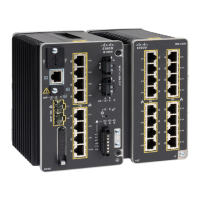1-4
Cisco IE 3000 Switch Software Configuration Guide
OL-13018-01
Chapter 1 Overview
Features
• Support for Cisco IOS IP Service Level Agreements (SLAs) responder that allows the system to
anticipate and respond to Cisco IOS IP SLAs request packets for monitoring network performance.
See the release notes for responder configuration
• Configurable small-frame arrival threshold to prevent storm control when small frames (64 bytes or
less) arrive on an interface at a specified rate (the threshold)
• Flex Link Multicast Fast Convergence to reduce the multicast traffic convergence time after a Flex
Link failure
Management Options
These are the options for configuring and managing the switch:
• An embedded device manager—The device manager is a GUI that is integrated in the software
image. You use it to configure and to monitor a single switch. For information about launching the
device manager, see the getting started guide. For more information about the device manager, see the
switch online help.
• Network Assistant—Network Assistant is a network management application that can be
downloaded from Cisco.com. You use it to manage a single switch, a cluster of switches, or a
community of devices. For more information about Network Assistant, see Getting Started with
Cisco Network Assistant, available on Cisco.com.
• CLI—The Cisco IOS software supports desktop- and multi-switching features. You can access the
CLI either by connecting your management station directly to the switch console port or by using
Telnet from a remote management station. For more information about the CLI, see
Chapter 2,
“Using the Command-Line Interface.”
• SNMP—SNMP management applications such as CiscoWorks2000 LAN Management Suite (LMS)
and HP OpenView. You can manage from an SNMP-compatible management station that is running
platforms such as HP OpenView or SunNet Manager. The switch supports a comprehensive set of
MIB extensions and four remote monitoring (RMON) groups. For more information about using
SNMP, see
Chapter 29, “Configuring SNMP.”
• CNS—Cisco Networking Services is network management software that acts as a configuration
service for automating the deployment and management of network devices and services. You can
automate initial configurations and configuration updates by generating switch-specific
configuration changes, sending them to the switch, executing the configuration change, and logging
the results.
For more information about CNS, see Chapter 5, “Configuring Cisco IOS CNS Agents.”
• CIP—Common Industrial Protocol (CIP) is a peer-to-peer application protocol that provides
application level connections between the switch and industrial devices such as I/O controllers,
sensors, relays, and so forth.You can manage the switch using CIP-based management tools, such
as RSLogix. For more information about the CIP commands that the switch supports, see the
Command Reference.
Manageability Features
These are the manageability features:
• CNS embedded agents for automating switch management, configuration storage, and delivery
• DHCP for automating configuration of switch information (such as IP address, default gateway,
hostname, and Domain Name System [DNS] and TFTP server names)
